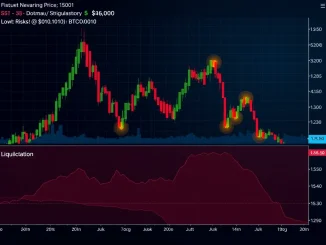
Buckle up, crypto enthusiasts! The crypto market mood ring, officially known as the Crypto Fear & Greed Index, has just flashed a significant signal. After lingering in the depths of ‘Extreme Fear,’ the index has made a dramatic leap, surging 21 points to land at 39. This jump propels us into the ‘Fear’ zone, indicating a palpable shift in crypto sentiment. But what does this mean for your Bitcoin and altcoin holdings? Let’s dive into the details and decode this crucial market indicator.
What is the Crypto Fear & Greed Index and Why Should You Care About Crypto Sentiment?
Imagine trying to navigate the turbulent waters of the cryptocurrency market without a compass. That’s essentially what investing without considering market sentiment is like. The Crypto Fear & Greed Index, provided by Alternative.me, acts as that compass, offering a snapshot of the prevailing emotions driving the crypto market. It’s a number between 0 and 100, where:
- 0-24: Extreme Fear – Suggests investors are excessively worried, potentially indicating a buying opportunity.
- 25-49: Fear – Indicates anxiety and caution in the market.
- 50-74: Greed – Signals growing optimism and potential for market exuberance.
- 75-100: Extreme Greed – Points to excessive optimism, possibly a sign of an impending market correction.
Why is this index so important? Because understanding crypto sentiment can be a powerful tool for making informed investment decisions. Just like in traditional markets, emotions play a huge role in the crypto space. Fear can drive prices down as people panic sell, while greed can inflate bubbles as everyone rushes to buy. By tracking the Fear & Greed Index, you gain insights into the collective psychology of the market, helping you to potentially:
- Identify potential buying opportunities during periods of extreme fear. When everyone else is selling, contrarian investors often see it as a chance to buy low.
- Recognize potential sell signals during periods of extreme greed. When euphoria takes over, it might be a good time to take profits before a potential downturn.
- Gauge the overall health and stability of the crypto market. Sudden shifts in the index can highlight changes in market dynamics.
Decoding the Jump: Why Did the Index Surge and What Does ‘Fear’ Mean for Bitcoin?
The recent 21-point jump is significant. Moving from ‘Extreme Fear’ to ‘Fear’ indicates a notable improvement in market sentiment. While we’re still in the ‘Fear’ zone, this upward trajectory suggests that the intense pessimism that gripped the market may be easing. Several factors could be contributing to this shift:
- Slight recovery in Bitcoin prices: Bitcoin, as the leading cryptocurrency, heavily influences overall market sentiment. A price rebound, even a modest one, can alleviate immediate fear.
- Reduced negative news flow: The crypto market is highly sensitive to news. A temporary lull in negative headlines (regulatory concerns, hacks, etc.) can contribute to improved sentiment.
- Anticipation of positive developments: Upcoming events like potential Ethereum upgrades or positive regulatory clarifications could be injecting cautious optimism into the market.
However, it’s crucial to remember that ‘Fear’ still dominates. This means caution is warranted. While the jump is encouraging, it doesn’t signal an ‘all-clear.’ The market is still characterized by anxiety and uncertainty. For Bitcoin and the broader crypto market, being in the ‘Fear’ zone typically suggests:
- Continued volatility: Fear often leads to erratic price swings as investors remain on edge. Expect potential ups and downs.
- Hesitancy to invest heavily: Many investors might remain sidelined, waiting for more concrete signs of sustained recovery before deploying significant capital.
- Potential for further downside: While sentiment is improving, underlying risks remain. ‘Fear’ can quickly escalate back to ‘Extreme Fear’ if negative catalysts emerge.
Delving Deeper: What Factors Fuel the Crypto Fear & Greed Index and Market Volatility?
The Crypto Fear & Greed Index isn’t based on guesswork. It’s a data-driven tool that analyzes six key factors to gauge market emotions. Understanding these components provides a more nuanced view of what’s driving market volatility and sentiment:
| Factor | Weighting | Description | Impact on Sentiment |
|---|---|---|---|
| Volatility (25%) | 25% | Measures the current and maximum drawdowns of Bitcoin, compared with the corresponding average values of the last 30 and 90 days. | High volatility often correlates with fear, while lower volatility can indicate reduced fear or increased greed. |
| Market Momentum/Volume (25%) | 25% | Compares the current market momentum and volume with the last 30 and 90-day averages, analyzing Bitcoin’s trading volume and momentum. | Strong momentum and high volume typically suggest greed, while weak momentum and low volume can indicate fear. |
| Social Media (15%) | 15% | Analyzes sentiment on social media platforms, particularly Twitter, for relevant crypto hashtags and keywords. | Positive social media sentiment often aligns with greed, while negative sentiment reflects fear. |
| Surveys (15%) | 15% | Conducts weekly crypto surveys to gauge investor sentiment directly. | Survey results directly reflect fear or greed based on participant responses. |
| Bitcoin Dominance (10%) | 10% | Measures Bitcoin’s dominance in the overall crypto market. An increase in Bitcoin dominance can sometimes indicate fear as investors flock to the perceived safety of Bitcoin. | Rising Bitcoin dominance can signal fear, while declining dominance might suggest increased risk appetite (greed) in altcoins. |
| Google Trends (10%) | 10% | Analyzes Google Trends data for Bitcoin-related search queries, particularly looking at search volumes and related trending topics. | High search volumes and positive trending topics can suggest greed, while declining search interest or negative trends may indicate fear. |
Actionable Insights: Navigating the ‘Fear’ Zone and Utilizing the Fear & Greed Index
So, the Crypto Fear & Greed Index is flashing ‘Fear’ – what should you do? Here are some actionable insights to consider:
- Don’t Panic: Fear is a natural part of market cycles. Avoid impulsive decisions based solely on fear.
- Do Your Own Research (DYOR): The index is a tool, not a crystal ball. Always conduct thorough research on projects before investing.
- Consider Dollar-Cost Averaging (DCA): In volatile periods, DCA can be a strategy to mitigate risk by investing a fixed amount at regular intervals, regardless of price fluctuations.
- Review Your Portfolio: Assess your risk tolerance and portfolio allocation. ‘Fear’ zones can be a good time to rebalance your portfolio and ensure it aligns with your long-term goals.
- Stay Informed: Keep track of the Fear & Greed Index and other market indicators, but don’t let them dictate your every move. Use them as part of a broader analysis.
Conclusion: Embracing Market Cycles and Understanding Crypto Sentiment
The Crypto Fear & Greed Index‘s jump into the ‘Fear’ zone is a noteworthy event, signaling a shift in crypto sentiment. While ‘Fear’ still prevails, the improvement from ‘Extreme Fear’ offers a glimmer of hope. Understanding this index and its underlying factors empowers you to navigate the inherent market volatility of the crypto space with greater awareness. Remember, market cycles are a constant. Fear and greed are inherent human emotions that drive these cycles. By recognizing and understanding these emotions, and utilizing tools like the Fear & Greed Index, you can make more informed decisions and potentially capitalize on opportunities that arise in both fearful and greedy market conditions. Keep a watchful eye on the index, stay informed, and happy investing!



